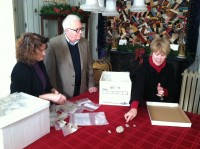Rare Find of Native American Artifacts Delivered to Historical Society

Brought in by four non-descript boxes, previously lost history found a new home at the Historical Society Inc. of Tarrytown and Sleepy Hollow Monday morning.
Hundreds of Native American artifacts were accepted by Historical Society executive director Sara Mascia and president Richard Rose and will eventually be used in an exhibition at the Grove St. location next year. Some of the nearly 400 artifacts date back to about 5,000 years.
Although the historical society has plenty of materials that date back a very long time ago, Rose said to get Native American findings from a local dig are rather rare to receive. When the Department of Environmental Protection approached him and the board about housing the artifacts, Rose said it was a no brainer to welcome it.
“I much more excited that the boxes are here and I really want to go through them,” Rose said. “It’s almost like Christmas day. You know you want to open up all the packages and see what’s really there.”
The materials in the boxes include 391 pieces of stone shatter, 12 projectile points, five bi-faces, two scrapers and two knives. The possibility of artifacts was discovered when the DEP started the construction of a water disinfection plant in Mount Pleasant and that’s when the Historical Perspectives, Inc. from Connecticut got involved.
President of Historical Perspective Cece Saunders, who delivered the boxes, said a find like this is a rare one. Saunders said she often finds colonial materials but it’s uncommon to find Native American tools like the ones dug up.
“From an archeologist’s point of view it’s like a birthday present and Christmas all kind of rolled into one,” Saunders said. “Because you never lose that magical sense that you’re touching something that a Native American was actually using to hunt for his food so it’s exciting and rare.”
The artifacts range in how long they date back. Some are from the archaic period, while others are from the woodlands period, which is just about 1,000 years ago, Saunders said. This shows the location where the artifacts were unearthed are a location that served the Native American well.
Although a date until it’s displayed is well off, Saunders said once it is made available to the public, the materials are great learning tools.
“It’s very hard to imagine just how a Native American is going to go after and kill his food,” Saunders said. “We are so far removed from that process.”
